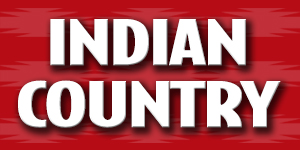Tribal members learn about unratified Virginia City Treaty
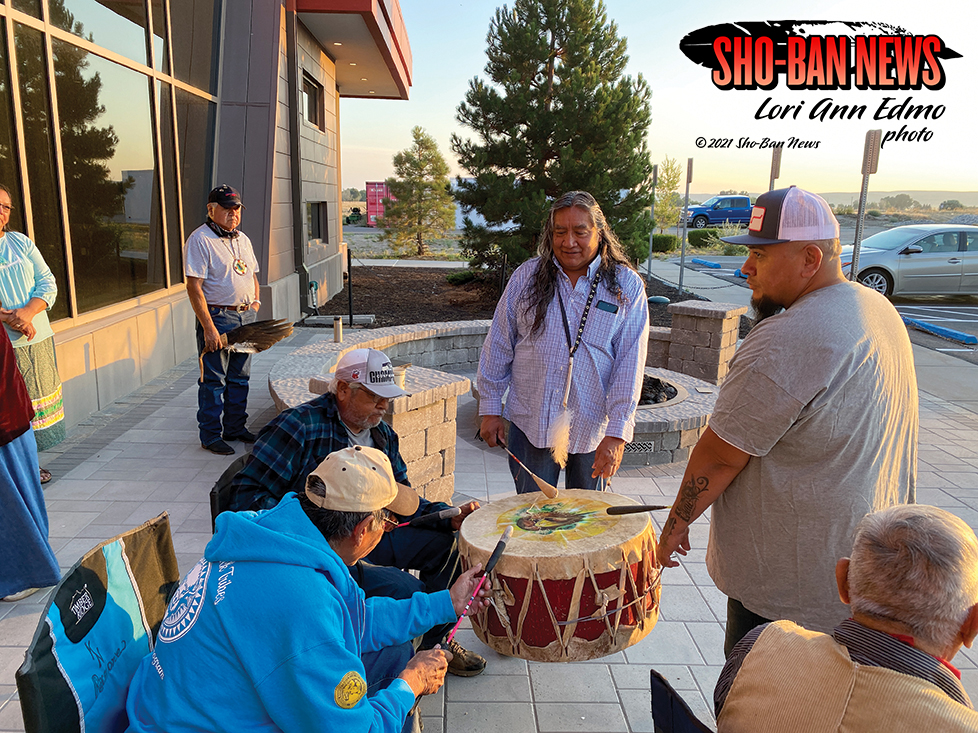
Nelson Racehorse and crew sing for the sunrise ceremony at the Virginia City Treaty Day Gathering on Saturday, July 17.
By LORI ANN EDMO
Sho-Ban News
FORT HALL — An event that is normally conducted at Virginia City, Montana was instead at the Shoshone-Bannock Events Center July 17 to help Shoshone-Bannock tribal members learn about the unratified Virginia City Treaty among the Shoshones, Bannocks and Sheepeaters that was signed September 24, 1868.
It was settled over a large extent of country westward from the Yellowstone to a mountain between the Bitterroot and Big Hole, running through Montana into Idaho according to the treaty.
The Shoshone-Bannock Tribes Language and Culture Department hosted the event that began with a sunrise ceremony at 6 a.m. and lasted throughout the day with afternoon events switching to the HRDC lawn where Indian games were conducted and a social powwow after a windstorm halted things temporarily.
Nelson Racehorse and crew sang prayer songs as the sun rose over the horizon next to the hotel. Darrell Shay told sunrise attendees a lot of information would be shared about the land that was stolen from us – all our ancestors that came from the Tukudeka, Agaideka Bozhenadeka – names of our ancestors. “There’s plenty of evidence that shows we were in Montana, Idaho and even in Wyoming. One of the places we were really entrenched was in Yellowstone National Park,” he continued. The gathering is to provide the information and encouraged people to ask questions of the staff.
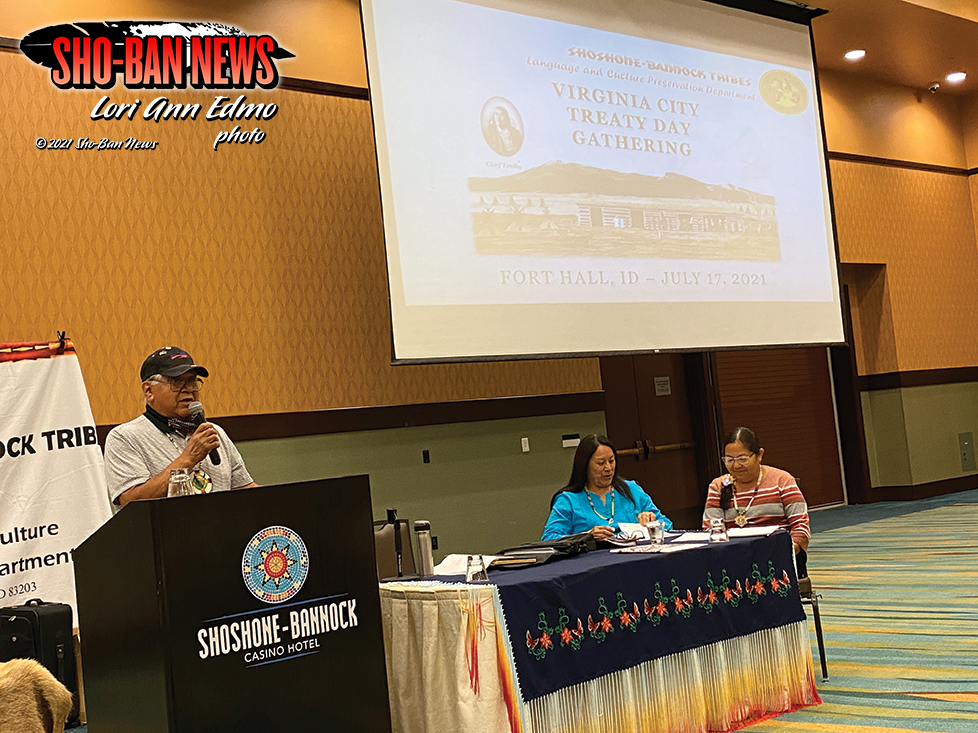
Darrell Shay speaks at the Virginia City Treaty Day Gathering at the Shoshone-Bannock Casino
Hotel event center.
Tribal Archivist Velda Racehorse served as the moderator saying there is a lot of people who have never been to Virginia City where the treaty was signed. Language and Culture Preservation Director Louise Dixey thanked Lee Juan for the prayers at sunrise and introduced LCPD staff who do the work to put on the events. She explained the Tribal Practices for Wellness grant from the Centers for Disease Control has been funded for a fourth year.
Fort Hall Business Council Chairman Devon Boyer said there’s a lot of things to take into consideration from reviewing documents, looking at maps and listening to the stories handed down in reference to this area. He said the Bannocks were in the hundreds on top of the mountains and battled the white people. The Indian Commission and agents at the time decided who should get what and it didn’t matter what we said. They were only interested in what they could take or what was occupied by them (settlers). He read through some documents the night before the event reading about Indian agents, governors, cavalry people, “All they did write letters about how Indians were stupid and ignorant.” Boyer said to this day, they continue to take. There will be continued fights and continued effort, “Probably long after us,” noting there are some folks that will admit Indians were here and the Sho-Bans were there. He encouraged tribal members to be cautious in future and participate as much as they can. “It all comes back to who we are, a people of prayer and I appreciate each and every one of you for being here this morning.”
FHBC member Lee Juan Tyler said the area is still ours, “We are still fighting for it,” and he thanked everyone for sharing good thoughts.
Nolan Brown, LCPD Original Territories researcher did a presentation about the basics of a treaty – the Virginia City Treaty and the area. He said work on it helped create the office he works at. A treaty is a formal agreement, compact, or contract between two or more sovereign nations that creates legal rights and duties for the contracting parties.
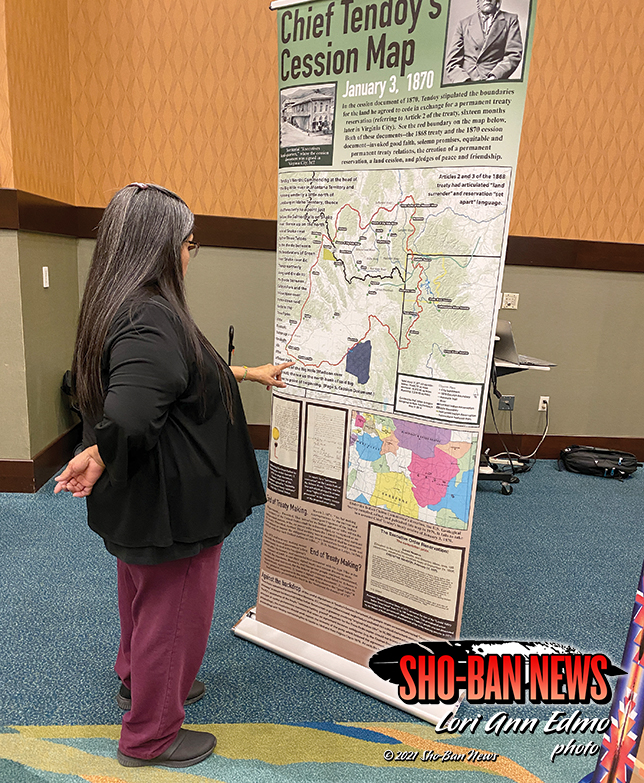
Rosemary Devinney looks at Chief Tendoy's Cession Map.
Treaties are agreements between self-governing or sovereign nations. Newenee and the United States have a deep history of treaty making. Bannock and Shoshone groups ranging in territories from modern day Idaho, Montana, Oregon, Nevada, Utah and Wyoming and beyond participated in a total of 12 treaty negotiations and many agreements with the U.S. The 374 ratified treaties tribes have with the U.S., the Constitution, clearly distinguish the independence American Indian nations have always had. The Bannocks, Shoshones and U.S. entered into diplomacy with nation-to-nation status and the Fort Bridger Treaty is the 373rd treaty or second to last to be ratified. The September 1868 Virginia City Treaty and the December 1868 Fort Harney Treaty were not ratified.
Brown noted the United States discontinued the treaty making process through an Act on March 3, 1871 when Congress inserted a rider in an appropriations bill that ended the process. Treaties are Supreme Law of the Land – in the U.S. Constitution Article VI Clause 2 – “This Constitution and the laws of the United States which shall be made in pursuance thereof; and all treaties made, or which shall be made, under the authority of the United States shall be the supreme law of the land; and the judges in every state shall be bound thereby, anything in the Constitution or laws of any state to the contrary notwithstanding.”
He showed a map of the treaties signed among Shoshone, Paiute and Bannocks. He said all of the treaties were of equal importance.
The Wihi’nite Committee followed with a presentation on the land claim. Committee members Darrell Shay, Jeanette Wolfley and Brenda Honena were present. Shay gave background information on the project that involves land restoration where the Virginia City Treaty was signed in 1868. He said they’ve been working on it since 2015. He said more members are needed and tribal members need to get involved.
Wolfley, tribal attorney, did a PowerPoint presentation. The September 24, 1868 Treaty was not ratified but recognized the use and occupancy by the Agai Deka people. It means there was no extinguishment of tribal ownership of lands. The January 3, 1870 Cession Agreement between Chief Tendoy and officials of the Montana Territory was signed. It was not ratified. The land was never given up to the United States. A map that was handed out showed the area that Wolfley explained. There was no land claim made. In 1875 an Executive Order established the Lemhi Reservation in Idaho but the creation of the Lemhi Reservation didn’t end the Agai Deka’s use of the lands in southwest Montana. They continued to hunt, fish and gather in the area with buffalo hunting continuing to be an important part of their use of the land. In 1905 some Agai Deka were forcibly removed to Fort Hall. However some refused to leave their homeland including Chief Tendoy who met with Fort Hall agents in Virginia City, Montana refusing to relocate. Agai Deka remained in southwestern Montana area and Idaho.
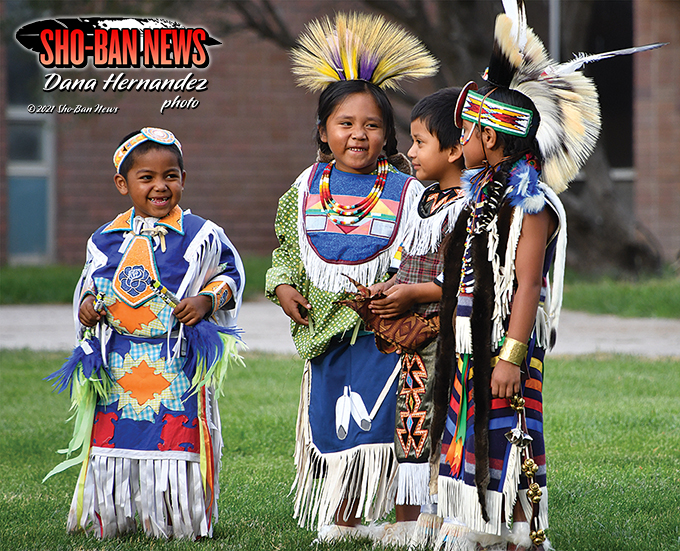
Junior boys laugh together during the powwow.
She explained in the 1940s the Shoshone and Bannock filed several land claims before the Indian Land Claims Commission and were compensated in the 1960s and 1970s. The Agai Deka Shoshone’s aboriginal title to lands in Montana was not among the matters litigated before the Indian Claims Commission. The Agai Deka Shoshone claims before the ICC were limited to the loss of lands in central and southern Idaho. No claims were filed for land in southwestern Montana. The Shoshone-Bannock Tribes claim based on original title is approximately 9 million acres of land comprised of federal, state and private lands but the Tribes recognized the amount of land could not be managed by the Tribes nor is it feasible to dislocate land owners. The 2012 Salazar trust settlement resolving tribal trust mismanagement claims against the U.S. reserved several matters for potential future claims against the U.S. It didn’t include the southwestern Montana claim.
She said tribal options include litigation, administrative remedy or legislative remedy.
The committee has conducted meetings with federal agencies; proposed field trips to federal lands; drafted legislation for the FHBC; drafted a proposed MOA with Yellowstone National Park and coordinates with the Language and Culture Preservation Department. Projects include land transfers, a cultural center, meeting rooms and housing; campgrounds; co-management agreements; trails, along with interpretive signs.
Honena said when the COVID-19 pandemic hit things came to a standstill but they’ve conducted Zoom meetings. She explained they received their tribal budget and were able to sponsor the lunch at the meeting that day.
Wolfley explained they need to continue to do education among the different entities.
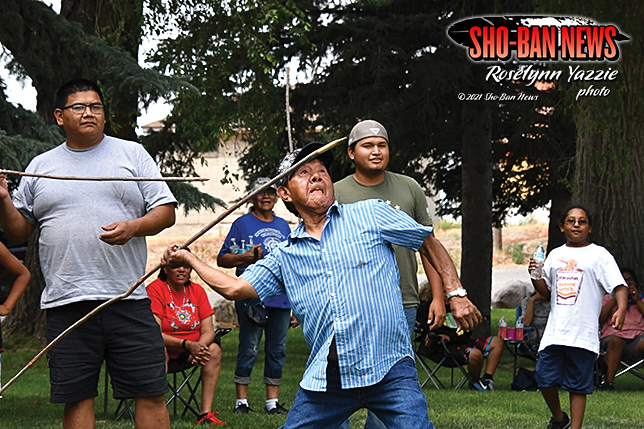
Eddy Nappo throws a spear during the traditional games.
LCPD Director Dixey said the Tribes Fisheries Department needs to be recognized for the work they do. “Our Tribes have really been advocates for protecting off reservation Treaty rights and tribal members teach their kids to learn where they came from.” She said next year is the 150 anniversary of Yellowstone Park and there’s 33 tribes who claim ties to the park. The Tribes need to stay on top of things.




